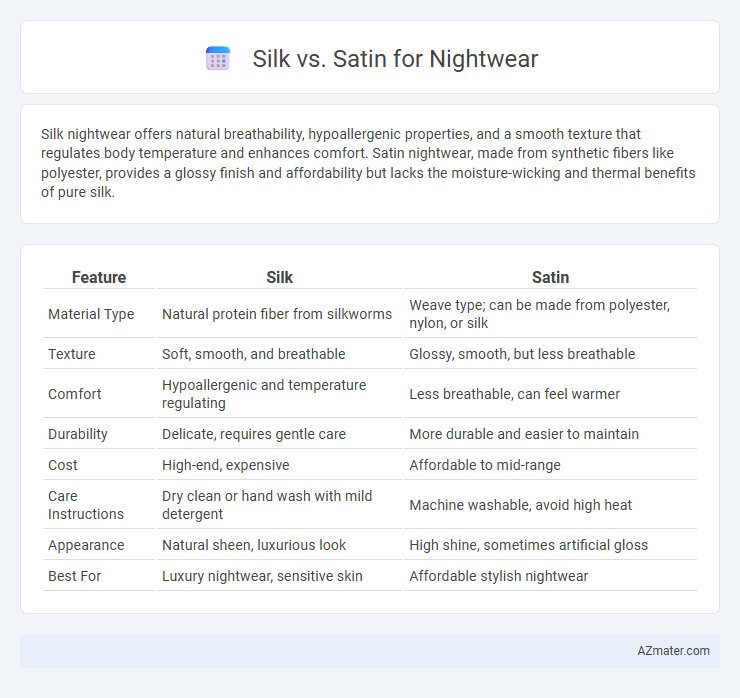Silk nightwear offers natural breathability, hypoallergenic properties, and a smooth texture that regulates body temperature and enhances comfort. Satin nightwear, made from synthetic fibers like polyester, provides a glossy finish and affordability but lacks the moisture-wicking and thermal benefits of pure silk.
Table of Comparison
| Feature | Silk | Satin |
|---|---|---|
| Material Type | Natural protein fiber from silkworms | Weave type; can be made from polyester, nylon, or silk |
| Texture | Soft, smooth, and breathable | Glossy, smooth, but less breathable |
| Comfort | Hypoallergenic and temperature regulating | Less breathable, can feel warmer |
| Durability | Delicate, requires gentle care | More durable and easier to maintain |
| Cost | High-end, expensive | Affordable to mid-range |
| Care Instructions | Dry clean or hand wash with mild detergent | Machine washable, avoid high heat |
| Appearance | Natural sheen, luxurious look | High shine, sometimes artificial gloss |
| Best For | Luxury nightwear, sensitive skin | Affordable stylish nightwear |
Introduction: Silk vs Satin Nightwear
Silk nightwear offers natural breathability and moisture-wicking properties, making it ideal for sensitive skin and temperature regulation during sleep. Satin, often made from synthetic fibers like polyester, provides a glossy finish and affordability but lacks the hypoallergenic benefits of silk. Choosing between silk and satin nightwear depends on preferences for comfort, durability, and budget, with silk being more luxurious and satin more accessible.
Fabric Composition and Origins
Silk nightwear, made from natural protein fibers produced by silkworms, boasts breathability and moisture-wicking properties ideal for sensitive skin. Satin, typically crafted from synthetic fibers like polyester or nylon, offers a glossy finish and smooth texture but lacks the natural breathability of silk. Originating from ancient China, silk represents luxury and tradition, whereas satin refers to the weave style that can be applied to various fibers, influencing durability and care requirements.
Feel and Comfort on the Skin
Silk nightwear offers a natural, breathable fabric that feels incredibly smooth and soft against the skin, making it ideal for temperature regulation and reducing irritation. Satin, often made from synthetic fibers, provides a glossy, slippery texture that glides over the skin but can trap heat and cause discomfort for some wearers. Choosing between silk and satin for nightwear largely depends on preference for breathable comfort versus a lustrous finish.
Breathability and Temperature Regulation
Silk nightwear excels in breathability due to its natural protein fibers, allowing better air circulation and moisture absorption, which helps regulate body temperature effectively. Satin, typically made from synthetic fibers like polyester, tends to trap heat and moisture, making it less ideal for maintaining a cool and comfortable sleep environment. Choosing silk nightwear enhances temperature regulation and comfort, especially in warmer climates or for those prone to overheating during sleep.
Durability and Longevity
Silk nightwear offers a luxurious feel but requires delicate care, as its natural fibers are prone to wear and tear, impacting durability and longevity. Satin, often made from synthetic fibers like polyester, provides greater resistance to abrasions and is easier to maintain, resulting in longer-lasting nightwear. Choosing satin nightwear can therefore be more practical for everyday use, while silk is ideal for occasional wear when softness and elegance are preferred.
Ease of Care and Maintenance
Silk nightwear requires delicate handling, often needing hand washing or dry cleaning to maintain its smooth texture and natural sheen. Satin, typically made from synthetic fibers like polyester, is more durable and machine washable, offering easier care and less risk of damage. Choosing satin for nightwear provides a low-maintenance option ideal for those seeking convenience without sacrificing a silky feel.
Allergy-Friendliness and Skin Benefits
Silk nightwear is highly hypoallergenic, naturally resistant to dust mites, mold, and bacteria, making it ideal for sensitive or allergy-prone skin. Satin, often made from synthetic fibers like polyester, may trap allergens and irritants, potentially aggravating skin conditions. Silk's smooth, breathable texture promotes moisture retention and reduces friction, benefiting skin health more effectively than satin.
Price Comparison and Value
Silk nightwear typically commands a higher price due to its natural protein fiber, breathability, and luxurious feel, often costing two to three times more than satin alternatives. Satin, usually made from synthetic fibers like polyester or nylon, offers a more affordable option while mimicking the smooth texture of silk but lacks the same durability and temperature-regulating properties. Investing in silk provides long-term value through comfort and longevity, whereas satin delivers budget-friendly elegance for short-term or casual use.
Style, Color, and Design Options
Silk nightwear offers a luxurious, natural sheen with rich, vibrant color retention, making it ideal for classic and elegant designs. Satin, typically made from polyester or synthetic blends, provides a glossy finish and a wide range of bold colors and patterns, catering to contemporary and trendy styles. Both fabrics support diverse design options, but silk is preferred for premium, breathable softness, while satin excels in affordability and versatility.
Final Verdict: Choosing the Best Nightwear Fabric
Silk offers unparalleled breathability, natural temperature regulation, and hypoallergenic properties, making it ideal for sensitive skin and luxurious comfort. Satin, often made from synthetic fibers, provides a smooth, glossy finish that mimics silk's elegance but lacks the same moisture-wicking and durability benefits. For nightwear prioritizing softness, durability, and skin health, silk is the superior fabric choice, while satin serves as a budget-friendly alternative with a similar aesthetic appeal.

Infographic: Silk vs Satin for Nightwear
 azmater.com
azmater.com